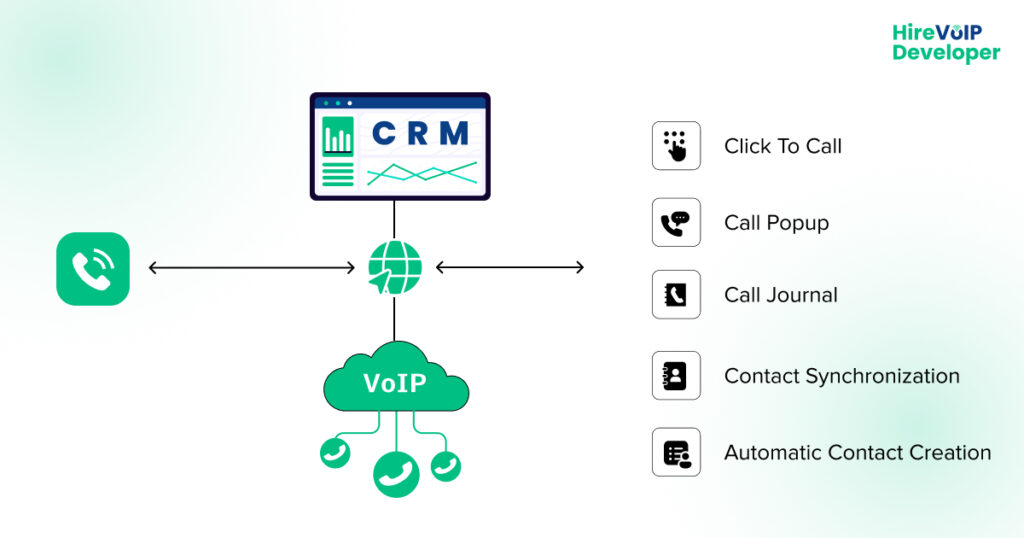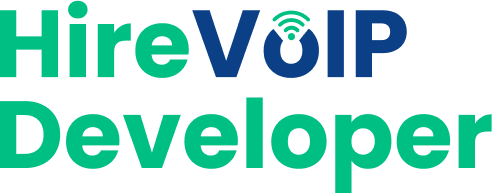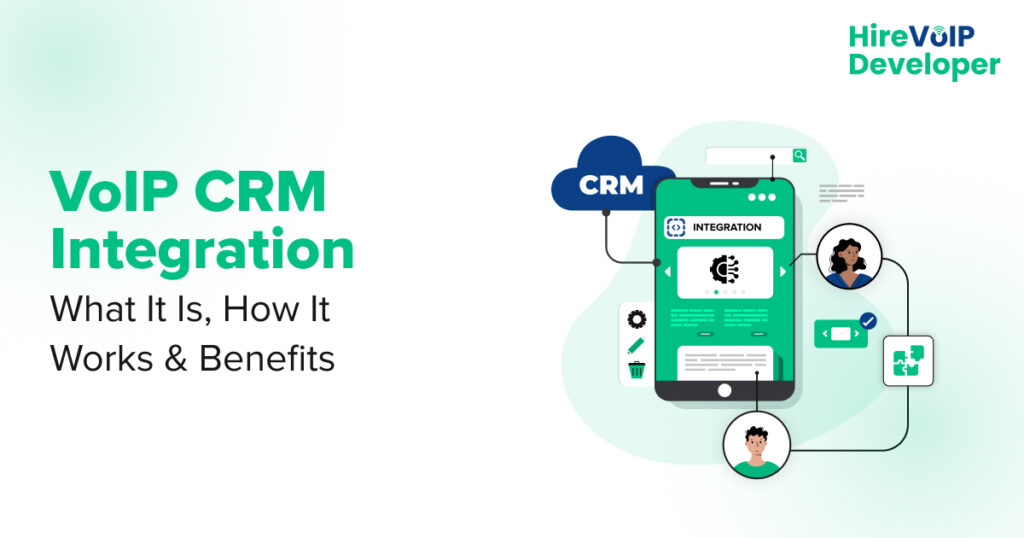📝 Blog Summary
This blog covers what VoIP and CRM are, how CRM with VoIP integration works, and the key benefits of integrating VoIP with CRM for smarter communication and better customer experiences. It also shares real-world use cases, fun facts, and how we simplify your integration journey.
What if your phone calls and customer data could work hand in hand?
Jessica is juggling calls and customer data all day. Every time someone calls, she’s flipping between tabs, hunting for details, and scribbling notes on paper.
It’s messy, slow, and stressful.🚩
With VoIP CRM integration, everything changes!
Caller info pops up instantly, she clicks to call, logs notes in one place, and never misses a follow-up.
Simple, smooth, and way more efficient!✅
That’s the power of VoIP CRM integration: it blends your calling system with your customer relationship management platform to streamline communication, boost productivity, and deliver better customer experiences.
Whether you’re in sales, support, or management, knowing how this integration works can help you make smarter business decisions.
🗝️ Key Highlights
- Streamlined workflows – VoIP CRM integration eliminates the need to switch between platforms, making customer interactions faster and more efficient.
- Real-Time Insights – Teams get instant access to caller details, history, and notes, leading to more personalized and informed conversations.
- Improved Customer Experience – With automation, context-rich calls, and centralized data, businesses can deliver smoother, more professional customer service.
Before we dive into how the integration works and why it matters, let’s quickly understand the basics, what exactly is VoIP, and CRM?
What is VoIP?
VoIP (Voice over Internet Protocol) is a technology that lets you make phone calls over the internet instead of traditional phone lines. It’s flexible, cost-effective, and comes with advanced features like call routing, voicemail-to-email, and call recording.
And, what is that CRM thing, you tend to integrate with your VoIP communications?
What is CRM?
CRM (Customer Relationship Management) systems help businesses manage customer interactions, track leads, and organize contact details in one place. CRMs like Salesforce, Zoho, or Microsoft Dynamics are commonly used to improve sales and support efficiency.
Now, what exactly does integrating a CRM with VoIP mean?
🚀 Unlock seamless communication by integrating VoIP with your CRM today.
What is VoIP CRM Integration?
VoIP CRM integration is the process of linking your internet-based phone system with your CRM software. When integrated, both platforms can share information in real time. For instance, if a customer calls, the CRM automatically displays their details, past interactions, notes, and order history, so your team can respond with full context.

Think of it as giving your phone system a brain. You’re not just receiving a call, you’re seeing exactly who’s calling and why they might be calling, without scrambling for details. This not only enhances customer service but also improves internal efficiency by reducing repetitive tasks.
Solutions like Dynamics CRM VoIP integration go a step further by offering tight native integration with enterprise tools.
The result?
A fully connected communication workflow where nothing falls through the cracks.📈
What More⁉️
65% of businesses say their sales teams are more productive after VoIP CRM integration, probably because they’re not busy typing up call notes at 9 p.m. anymore.
But How Does VoIP CRM Integration Work?
Let’s break down the nuts and bolts of how CRM with VoIP integration actually works in a real-world business environment.
At its core, this integration is about allowing two powerful systems, your VoIP communication platform and your CRM software, to share information automatically. The idea is simple: instead of toggling between your CRM to look up customer data and your VoIP tool to make calls, the two systems are connected so they function as one smooth, efficient platform.
Here’s how it works step by step –
1. Platform Compatibility and Integration Method
The first step is choosing a VoIP service and CRM that are compatible. Many CRMs today, such as HubSpot, Salesforce, Zoho, and Microsoft Dynamics, offer native or third-party support for popular VoIP providers. If you’re using Dynamics CRM VoIP integration, for example, Microsoft’s ecosystem already provides native integration with platforms like Teams or third-party VoIP tools.
2. Connection via API or Plug-in
Once compatibility is confirmed, integration is done using APIs or plug-ins. APIs (Application Programming Interfaces) act like messengers between the two platforms, sharing data in real-time. Most integrations involve a simple setup process, often requiring just a few authentication steps and configuration options.
3. Call Data Synchronization
After integration, the system syncs call activity with the CRM. This includes –
- Incoming and outgoing call logs
- Caller ID with linked contact records
- Call duration and timestamps
- Notes taken during or after the call
- Call recordings (if enabled)
Imagine getting a call, and as the phone rings, your CRM shows you the caller’s name, account history, and any open support tickets, no manual lookup needed!
Pro Tip –
Bonus Insights! 📈
Businesses that use CRM & VoIP integration see up to 30% more closed deals, because knowing your customer before you even say “Hello” is a game-changer.
4. Click-to-Call & Real-Time Popups
One of the most appreciated features of VoIP CRM integration is click-to-call. Sales and support teams can simply click on a contact’s phone number in the CRM, and the VoIP app initiates the call instantly. This eliminates dialing errors and saves time.
During live calls, many systems also display real-time “screen pops” showing the caller’s information. This allows agents to provide personalized service from the first second of the conversation.
5. Workflow Automation and Logging
Integrated systems can trigger workflows based on call outcomes. For example –
- A missed call can automatically create a follow-up task.
- A completed call can prompt a survey or send a follow-up email.
- Notes and dispositions can be required before ending a call.
These automation features are what elevate the experience from a basic VoIP integration to a fully functional business tool. When properly configured, the best CRM VoIP integration not only connects systems but also enhances them.
Do you know?👀
Heads up!
With click-to-call features in integrated systems, you can dial a number faster than your coffee machine starts brewing. ☕️
Now that you know how VoIP CRM integration brings your communication and customer data into one streamlined system, let’s explore the real value it adds to your business.
Here are the top benefits you can expect.
What are the Benefits of VoIP CRM Integration?
Now that you know how it works, let’s talk about why businesses are prioritizing VoIP and CRM integration benefits more than ever.
Here are the key advantages, explained in depth
1. 360° Customer View at Your Fingertips
With your VoIP CRM setup, every phone call becomes an informed interaction. When a customer calls, your team instantly sees their previous interactions, notes from other agents, purchase history, and any ongoing issues. This context allows for faster resolutions, fewer call transfers, and stronger customer relationships.
2. Faster, Smarter Workflows
No more switching between tabs or scribbling call notes on sticky notes. With CRM and VoIP integration, all call details are logged automatically. This not only saves time but ensures accuracy and accountability. Follow-ups can be scheduled right after the call, and reminders can be triggered if tasks are incomplete.
3. Improved Productivity and Efficiency
Click-to-call functionality means your team spends less time dialing numbers and more time talking to customers. Pair that with real-time data access, and the result is a huge productivity boost. Integrated dashboards give managers a clear overview of call performance, activity logs, and team responsiveness.
4. Enhanced Customer Experience
Customers hate repeating themselves. Integrated systems ensure they don’t have to. From support tickets to sales interactions, everything is centralized. This continuity builds trust and makes your business appear more competent and reliable.
Do you know?👀
🔄 Weird but true!
CRM stands for “Customer Relationship Management,” but it might as well mean “Constantly Refreshing Multiple-tabs”… unless, of course, you integrate it with VoIP!
5. Data-Driven Decision-Making
Want to know how many calls led to closed deals? Or which agents spend the most time on high-value clients? With detailed call logs and CRM data merged, reporting becomes smarter and more actionable. Management can spot trends, allocate resources better, and make strategic decisions with confidence.
6. Better Team Collaboration
When all call records, notes, and customer data live in one system, collaboration across departments becomes seamless. A salesperson can easily pick up where a support agent left off, or marketing can segment customers based on call history for personalized campaigns.
7. Scalability and Flexibility
One of the underrated VoIP and CRM integration benefits is how scalable the solution is. Whether you’re a team of 10 or 500, modern integrated VoIP solutions grow with you. Adding new users or expanding to remote teams becomes effortless because everything is cloud-based and centrally managed.
8. Stronger Compliance and Security
When using regulated CRMs like Dynamics, Dynamics CRM VoIP integration offers robust compliance features such as encrypted call logs, access control, and audit trails. This is particularly beneficial for industries like healthcare, finance, or legal services.
Together, these benefits form a compelling reason why CRM with VoIP integration is no longer just a “nice-to-have” – it’s a business essential. Whether you’re streamlining sales processes, elevating customer service, or aiming for operational excellence, VoIP CRM capabilities give your team the tools to succeed.
As the core benefits of VoIP CRM integration continue to transform daily operations, the latest trends are pushing those capabilities even further, making communication smarter, faster, and more intuitive than ever before.
What are the Latest Emerging Trens for VoIP CRM Integration?
As of 2025, VoIP CRM integration continues to evolve rapidly, especially with the rise of AI, remote work, and advanced automation. Here are some of the latest emerging trends shaping the future of this space –
1. AI-Powered Call Insights
AI is increasingly being used to transcribe calls, analyze sentiment, and summarize conversations. These insights are auto-logged into the CRM, helping sales and support teams follow up more effectively without manual note-taking.
2. Omnichannel Integration
More businesses are moving beyond just voice calls. VoIP platforms are now syncing with CRMs to include chat, SMS, email, video calls, and social messaging, all tracked in one unified customer timeline. This gives teams a 360-degree view of every interaction.
3. Real-Time CRM Data Suggestions During Calls
Modern VoIP CRM integrations are getting smarter, providing live data prompts during calls. For example, if a customer mentions an issue, the system might suggest a related support article or highlight relevant purchase history right inside the CRM interface.
4. Mobile-First Integration
With remote and hybrid work becoming the norm, many CRMs and VoIP systems are optimizing their mobile apps. Teams can now make and log calls, access customer details, and get real-time notifications, all from their phones.
5. Low-Code/No-Code Integration Tools
Integrating VoIP and CRM used to require heavy IT involvement. Now, platforms like Zapier, Make, and native integration marketplaces offer low-code or no-code options, making it easier for even non-technical users to set up workflows.
6. Deeper Analytics and Predictive Reporting
Advanced integrations now pull in call patterns, deal outcomes, and agent behavior to generate predictive insights, such as which leads are most likely to close, or which support tickets are at risk of escalation.
7. Tighter Security and Compliance Features
With growing concerns around data privacy (especially in industries like healthcare and finance), VoIP and CRM platforms are adding features like call encryption, two-factor authentication, and compliance automation (e.g., GDPR, HIPAA).
8. Integration with Workflow Automation Tools
VoIP CRM integration is increasingly being tied into larger business automation stacks, for example, triggering Slack alerts after a call, or creating tasks in project management tools like Asana or Trello based on call outcomes.
While integrating VoIP into your CRM does come with a few hurdles, staying aware of the latest trends can help you overcome those challenges and future-proof your communication strategy.
What Are the Challenges of VoIP CRM Integration?
While the benefits are impressive, it’s also important to understand the potential roadblocks when integrating VoIP into CRM systems. No system upgrade is completely plug-and-play, and being prepared helps you avoid unnecessary frustration.
1. Compatibility Issues
Not all CRMs and VoIP platforms speak the same language. If you’re not using tools that support native or third-party integration, you may run into technical snags. That’s why researching the best VoIP to integrate with CRM is a crucial first step.
2. Initial Setup Complexity
Even with compatible systems, the setup process can feel a little technical, especially if your team isn’t familiar with VoIP or CRM configurations. You might need help from IT or vendor support to properly map call data fields and enable features like screen pop-ups or call logging.
3. Training Requirements
Your team needs to know how to use the new system effectively. Without proper onboarding, features may go unused or get misused, which defeats the purpose of the integration. A short training session can go a long way in making the transition smooth.
4. Data Sync and Security Concerns
Syncing customer data across platforms means sharing sensitive information between systems. Ensuring both tools have strong security policies and data encryption in place is essential. Always verify what security measures your VoIP and CRM providers follow.
5. Cost Considerations
Some integrations require add-ons or third-party tools, which can increase your overall costs. It’s important to factor these into your budget when planning your upgrade.
While the road to integration may come with a few bumps, the long-term gains far outweigh the initial hurdles.
Now that we’ve looked at the challenges, let’s wrap up with why VoIP CRM integration is still a smart move for forward-thinking businesses.
📞💼 Supercharge your CRM with VoIP integration for smarter calls!
Wrapping Up
In today’s fast-moving business world, juggling customer data and communication tools separately just doesn’t cut it. VoIP CRM integration brings everything into one place—so your team stays focused, responsive, and one step ahead.
Here’s what we covered
- What VoIP and CRM are, and why they’re essential for modern businesses,
- How CRM with VoIP integration works behind the scenes, and
- The key VoIP and CRM integration benefits that drive productivity and customer satisfaction.
At Hire VoIP Developer, we make VoIP CRM integration simple and seamless. We help connect your existing VoIP system to your CRM smoothly, with no tech headaches, just smarter workflows.
Let us handle the integration, so your team can focus on what really matters: your customers!


